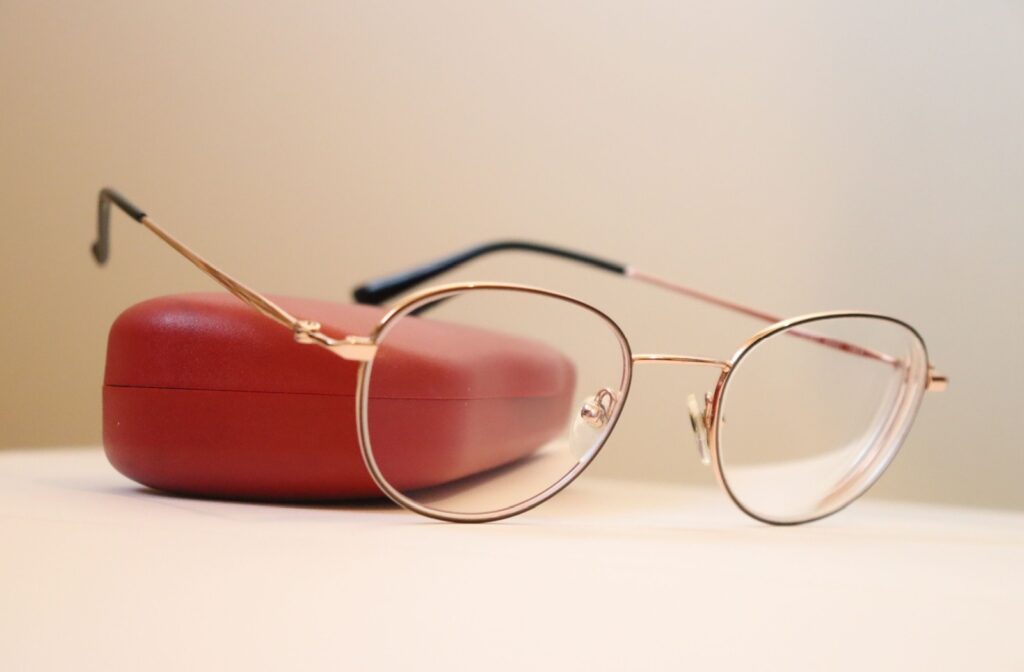If you’ve ever wondered whether eyeglass and contact lens prescriptions are the same, you’re not alone. This is actually a common question! While both contact lens and glasses prescriptions aim to improve vision, they can’t be used interchangeably.
Let’s have a closer look at what this means.
What Goes into a Prescription for Glasses?
Glasses rest about 12 millimeters away from your eyes. This distance matters because it affects how light is focused onto your retina, the layer of tissue at the back of your eye that sends visual signals to your brain. A prescription for glasses will typically include these components:
Sphere (SPH)
This measures the lens power, in diopters (D), needed to correct vision issues like nearsightedness (myopia) or farsightedness (hyperopia). A negative SPH value indicates myopia, where close objects are clear, but distant objects appear blurry, while a positive SPH value indicates hyperopia, where distant objects are clear, but near objects are blurry. If the SPH value is 0.00 (plano), no spherical correction is required. SPH values are used in prescriptions for eyeglasses and contact lenses, typically ranging from -20.00 to +20.00, depending on the severity of the vision problem.
Cylinder (CYL)
If you have astigmatism, this value indicates the lens power needed to correct it. The CYL value indicates the degree of correction required, with a negative value for concave lenses and a positive value for convex lenses. If no CYL value is listed on a prescription, it means there is no astigmatism or it is too minor to require correction. This measurement is commonly used in eyeglass and contact lens prescriptions to improve visual clarity for those with astigmatism.
Axis
Axis indicates the orientation of astigmatism correction in the lens, measured in degrees from 1 to 180. It specifies the angle at which the cylindrical power of the lens must be positioned to correct uneven curvature in the eye. The axis is only included in prescriptions when there is a Cylinder (CYL) value, as it works together with CYL to correct astigmatism. A low axis value (close to 1) aligns correction horizontally, while a high value (close to 180) aligns it vertically. This precise measurement ensures clear and accurate vision correction.
Addition (ADD)
Found in prescriptions for multifocal lenses, this value indicates the additional magnification required for reading or close-up work.
How Are Contact Lens Prescriptions Different?
Unlike glasses, contact lenses sit directly on the surface of your eye. This changes how the lens refracts light onto your retina, and means that the prescription values for contact lenses will be a little bit different.
Contact lens prescriptions include sphere, cylinder, and axis, but they also require some other measurements to make sure that the lenses fit your eye. In cases of astigmatism, special toric lenses may be required.
Here’s what you’ll find in a contact lens prescription:
Base Curve (BC)
Base Curve (BC) refers to the curvature of a contact lens, measured in millimeters, and is designed to match the shape of your cornea for a comfortable fit and proper vision correction. A lower BC value indicates a steeper lens, while a higher value represents a flatter lens. Choosing the correct base curve ensures the lens stays centered on the eye, provides optimal comfort, and reduces the risk of irritation or complications. BC is a crucial component of a contact lens prescription tailored to your specific eye shape.
Diameter (DIA)
Diameter (DIA) refers to the overall width of a contact lens, measured in millimeters, and determines how the lens fits on your eye. It ensures that the lens properly covers the cornea and rests comfortably on the sclera (the white part of the eye). DIA values typically range from 13.5 mm to 15 mm for soft contact lenses, with the specific measurement depending on the size and shape of your eye. An accurate DIA is essential for a stable fit, clear vision, and overall lens comfort.
Lens Material or Brand
Contact lens prescriptions often specify a particular brand or material, as different materials or brands can be better suited to different situations.
Why the Differences Matter
The primary reason why glasses and contact lens prescriptions differ is the positioning of the lenses. Glasses sit a short distance away from your eyes, while contact lenses rest directly on the cornea. This affects how light is refracted by the lens into the eye and how much power the lens needs in order to correct your vision.
Contact lenses also need to account for the shape of your cornea.
The Importance of Separate Exams

If you’re considering both eyeglasses and contact lenses, you’ll need separate prescriptions, each of which requires specific exams. A standard eye exam will determine your overall vision needs and provide a prescription for eyeglasses. However, a contact lens exam includes additional steps to help the lenses fit your eyes properly. These steps include:
- Measuring the curvature of your cornea to determine the base curve.
- Evaluating the size of your iris and pupil.
- Assessing your tear film to ensure that your eyes produce enough moisture.
- A trial fitting to evaluate how the lenses sit on your eyes and how they affect your vision.
Skipping a contact lens exam and attempting to use your eyeglass prescription could lead to discomfort or even potential damage to your eyes. Each prescription is designed to meet specific demands.
Risks of Using the Wrong Prescription
Using an incorrect prescription—whether for eyeglasses or contact lenses—can lead to a range of issues. For eyeglasses, an inaccurate prescription might cause headaches, eye strain, or blurry vision. With contact lenses, the risks can be more severe, including discomfort, eye infections, or damage to the cornea.
That’s why it’s crucial to rely on your eye care professional for accurate prescriptions and guidance. Never attempt to convert one type of prescription into another on your own.
Keeping Your Prescriptions Up to Date
Both eyeglass and contact lens prescriptions expire, typically after one to two years. Regular eye exams can help your prescriptions remain accurate. During these visits, your optometrist can also detect changes in your vision or early signs of eye conditions.
At Eclectic Eyewear, we recommend annual check-ups for contact lens wearers and biennial exams for those who only wear glasses. Staying proactive about your eye health is a way to make sure your vision correction is always up to date.
Trust Eclectic Eyewear for Your Vision Needs
At Eclectic Eyewear, we understand that your vision is as unique as you are. Whether you prefer eyeglasses, contact lenses, or both, we’re here to provide personalized care and guidance. With a focus on technology and a wide range of fashionable frames, we’re committed to helping you see clearly with style.
If you’re ready to update your prescription or explore new eyewear options, visit Eclectic Eyewear. Our convenient location near the University of Texas at Austin makes it easy to stop by and discover frames you won’t find anywhere else. Schedule an appointment today to experience the difference of personalized eye care.


